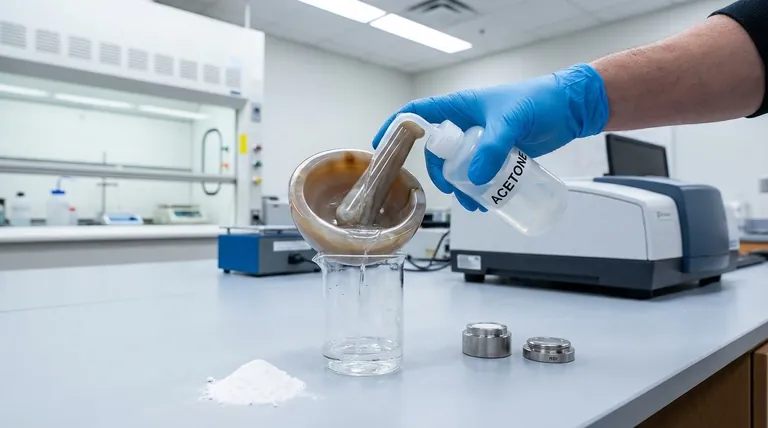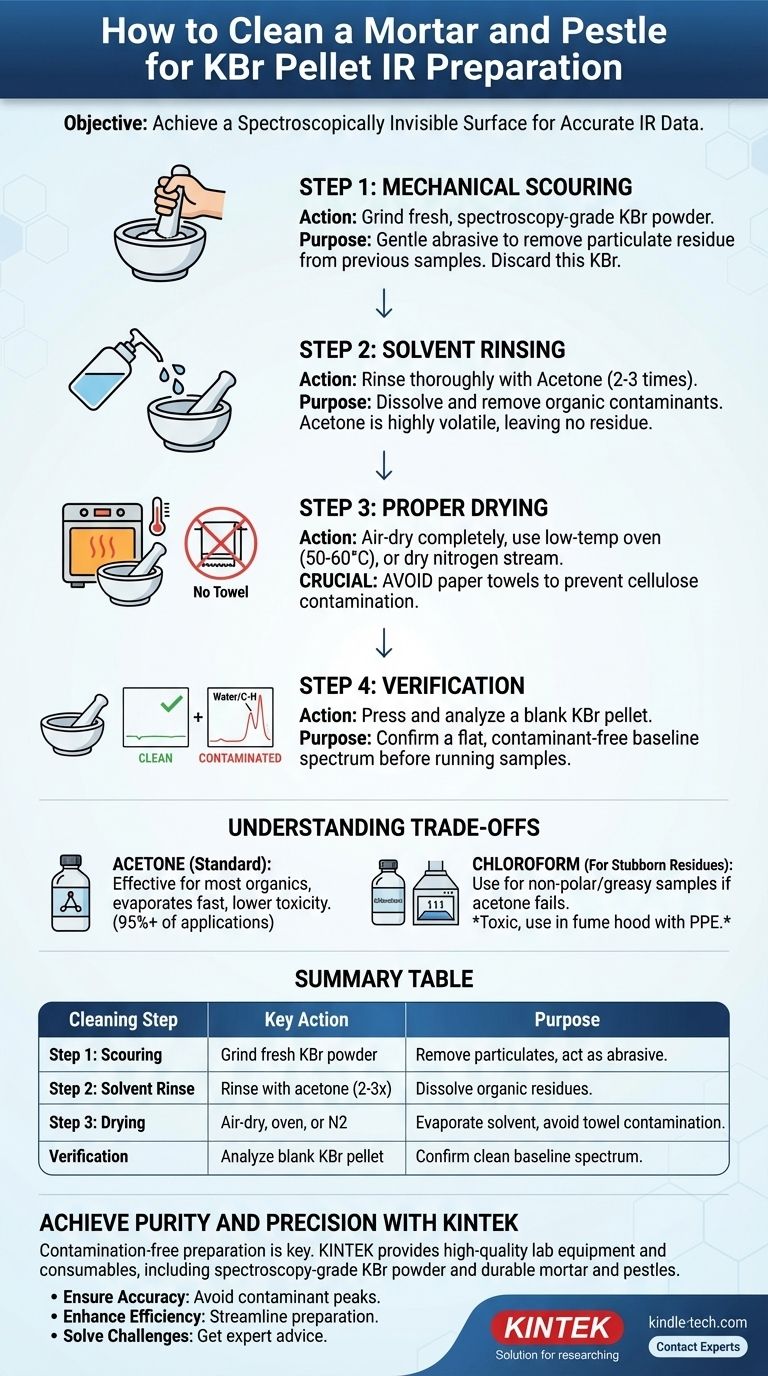为了正确清洁研钵和杵以制备 KBr 压片,您必须使用高度挥发的有机溶剂,如丙酮。目标是彻底去除任何可能干扰样品红外(IR)光谱的有机残留物或水分,确保收集到的数据准确且无污染。
其核心目标不仅仅是清洁研钵,而是使其在光谱学上“隐形”。这需要一个多步骤的过程,以消除任何可能吸收红外辐射并掩盖样品真实信号的物质,包括清洁剂本身。
为什么一丝不苟的清洁是不可或缺的
红外光谱技术非常灵敏,能够检测到微量的物质。这种灵敏度是一把双刃剑;任何残留在研钵和杵中、来自先前分析、操作或清洁过程本身的污染物都很容易出现在您的最终光谱中。
污染问题
即使是手指留下的微量油脂、先前样品的残留物或吸收的大气水蒸气,都会在红外光谱中产生明显的峰。这些污染物峰可能会与您样品的峰重叠,导致数据被误读或完全掩盖您试图测量的信号。
理想溶剂的特性
用于红外制备的合适清洁溶剂必须具备两个关键特性。首先,它必须能有效溶解各种有机化合物。其次,它必须是高度挥发性的,这意味着它会完全且快速地蒸发,不留下任何残留物。丙酮是标准选择,因为它在这两个方面都表现出色。

明确的清洁方案
简单的擦拭是不够的。请遵循以下程序,以确保您的设备真正准备好进行分析。
步骤 1:机械擦洗
在使用任何溶剂之前,先进行物理清洁步骤。在研钵中研磨少量新鲜的、光谱级 KBr 粉末。这起到温和研磨剂的作用,可以擦去可能嵌入研钵微小孔隙中的先前样品残留的任何颗粒物。丢弃此 KBr。
步骤 2:溶剂冲洗
用丙酮彻底冲洗研钵和杵。使用洗瓶冲洗表面,确保覆盖整个研磨区域和杵尖。最佳做法是进行两到三次冲洗,以确保所有可溶性污染物都被清除。
步骤 3:正确干燥(关键)
这是最常见的失败点。不要使用纸巾或实验室纸来擦干设备。这些材料由纤维素制成,纤维素具有非常强烈且特征性的红外吸收,会污染您的压片。
相反,让研钵和杵完全风干。为了加快速度,您可以将它们放入低温烘箱(例如 50-60 °C)中几分钟,或使用一股干燥的氮气流。
理解权衡
虽然丙酮是首选,但在特定情况下也可以使用其他溶剂。
丙酮:标准选择
丙酮对大多数常见的有机残留物有效,蒸发极快,与其它选择相比毒性相对较低。对于超过 95% 的应用,它是正确且充分的选择。
氯仿:用于顽固残留物
在存在来自非极性、油腻或聚合物样品的严重污染的情况下,氯仿可以成为更有效的溶剂。然而,它的毒性更高,需要在通风橱中佩戴适当的个人防护设备进行操作。只有当丙酮未能产生干净的背景时,才应考虑使用氯仿。
如何验证您的清洁效果
清洁程序的最终检验是压制一个“空白”压片。这是一个仅使用您库存瓶中 KBr 粉末制成的压片。
对这个空白 KBr 压片进行红外光谱分析。所得光谱应该是一条平坦的线,具有最少的吸收峰。如果您在水(约 3400 cm⁻¹ 处的宽信号)或 C-H 键(约 2900 cm⁻¹ 处)处看到明显的峰,则说明您的清洁和干燥过程不充分。
- 如果您的主要重点是常规分析:彻底的丙酮冲洗后进行风干或烘箱干燥是一种可靠且高效的方案。
- 如果您的主要重点是痕量分析或弱信号样品:在投入您宝贵的样品之前,务必先运行一个空白 KBr 压片以确认干净的背景。
- 如果您怀疑有非极性样品污染:首先使用丙酮,只有当空白光谱仍显示污染时,才进行氯仿冲洗。
纯净的光谱始于纯净的制备。
摘要表:
| 清洁步骤 | 关键操作 | 目的 |
|---|---|---|
| 步骤 1:擦洗 | 研磨新鲜 KBr 粉末 | 去除颗粒物并起到研磨剂的作用。 |
| 步骤 2:溶剂冲洗 | 用丙酮彻底冲洗(2-3 次) | 溶解并去除有机残留物。 |
| 步骤 3:干燥 | 风干或使用低温烘箱/干燥氮气 | 使溶剂完全蒸发;避免纸巾污染。 |
| 验证 | 压制并分析空白 KBr 压片 | 确认红外光谱中干净、平坦的基线。 |
在您的实验室中实现纯度和精度
无污染的样品制备是可靠的红外光谱数据的基础。KINTEK 专注于提供高质量的实验室设备和耗材,包括光谱级 KBr 粉末和耐用的研钵和杵套装,旨在满足分析实验室的严格要求。
让我们的专业知识支持您的研究:
- 确保准确性:使用我们推荐的材料,避免光谱中出现污染物峰。
- 提高效率:使用可靠、一致的产品来简化您的制备过程。
- 解决挑战:针对痕量分析或顽固污染问题获得个性化建议。
准备优化您的红外样品制备吗? 立即通过我们的联系表单联系我们的专家,讨论您的特定实验室需求,并了解 KINTEK 如何帮助您取得卓越成果。
图解指南




















